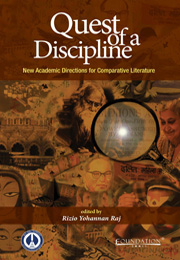Book contents
- Frontmatter
- Contents
- List of Contributors
- Acknowledgements
- Prologue to the “Quest'
- Introduction
- PART I Traditions and Manifestoes: Reflecting on Perspectives
- PART II The Quest Motif: Redefining the Scope of Comparative Literature
- PART III The Dynamics of Exchange: Genres, Areas and Disciplines
- 10 Text and Performance: A Study in Cultural Symbiosis with Special Reference to Kathakali
- 11 The Indian Cartoon Art: A Paradigm for the Emerging Text and Image Experience
- 12 Text and Alter Text: Chinese Literature in Indian Translations
- 13 Arabic Literature in Diaspora: An Example from South Asia
- 14 Literature, Arts and Social Sciences: Interdisciplinary Comparative Advantage
- PART IV India: A Curious Comparative Space
- Afterword: Comparative? Literature?
- Index
13 - Arabic Literature in Diaspora: An Example from South Asia
from PART III - The Dynamics of Exchange: Genres, Areas and Disciplines
Published online by Cambridge University Press: 05 June 2012
- Frontmatter
- Contents
- List of Contributors
- Acknowledgements
- Prologue to the “Quest'
- Introduction
- PART I Traditions and Manifestoes: Reflecting on Perspectives
- PART II The Quest Motif: Redefining the Scope of Comparative Literature
- PART III The Dynamics of Exchange: Genres, Areas and Disciplines
- 10 Text and Performance: A Study in Cultural Symbiosis with Special Reference to Kathakali
- 11 The Indian Cartoon Art: A Paradigm for the Emerging Text and Image Experience
- 12 Text and Alter Text: Chinese Literature in Indian Translations
- 13 Arabic Literature in Diaspora: An Example from South Asia
- 14 Literature, Arts and Social Sciences: Interdisciplinary Comparative Advantage
- PART IV India: A Curious Comparative Space
- Afterword: Comparative? Literature?
- Index
Summary
INTRODUCTION
The famous Orientalist and explorer, Sir Richard Burton wrote: ‘It is generally said that the sun does not rise upon a land that does not contain a man from Hadhramawt.’ (Burton 58)
This essay might be considered the preliminary phase of a comprehensive scheme to study Arabic literature in diaspora. Here, I deal with the literature of Hadhrami Arabic, the variety of Arabic spoken in Hadhramawt vis-a-vis the regions to which the Hadhramis migrated and settled. The term Hadhramawt (also spelt Hadhramout and transliterated Ḥaḍramawt), as used in this literary historical study, refers to the territory known as the Qu'aiti and Kathiri Sultanates in Southern Arabia prior to 1967. It comprises the coastal region and the interior, which is also known as Wadi Hadhramawt.
In this essay, we will try to examine the impact of the Hadhrami diaspora in South Asia in terms of language and literature. We shall also try to consider an example of the interaction between the diasporic literature and the political scene in the homeland.
Historical Preamble
South Arabians, in general and the people of Hadhramawt in particular, boast of having a legendary history reflected in the past of their region as a seat of an ancient civilization. Hadhramawt had been one of the Southern Arabian kingdoms along the trade routes of the ancient world. Commodities like frankincense, myrrh and resin gums which were produced in Southern Arabia were used in the Near East and the Mediterranean world for religious and medicinal purposes.
- Type
- Chapter
- Information
- Quest of a DisciplineNew Academic Directions for Comparative Literature, pp. 191 - 212Publisher: Foundation BooksPrint publication year: 2012

